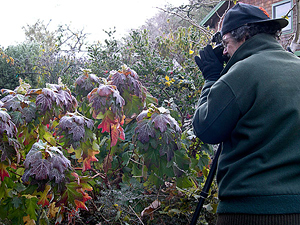For those of you in real winter climates, please humor this Californian who went photo crazy in the garden the other morning when it got all the way down to 24. Some of you only wish it might get up to 24. If crunching across the frozen grass is no rare sensory treat that gets the creative juices flowing for you, then simply enjoy some frosty photos.
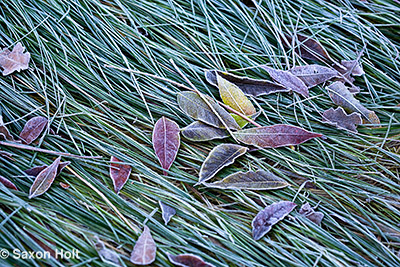
crunchy frozen grasss
I had just raked most of the leaves off my little Festuca rubra meadow last week-end, so the long floppy blades lay flat like flowing water. The last few Pistache leaves dropped in the cold snap and with a little care looking into the camera (always with tripod), a composition composed itself. The default white balance settings on my camera wanted this to be a much warmer image, but cold needs to be blue.
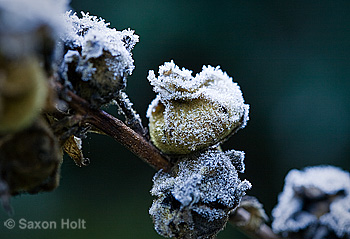
These hollyhock seedpods make me cold even looking at it now and I remember thinking I need to find some warm colors in the garden to contrast with the frost. My berberis was just beginning to turn and the cold weather has now pushed it along.
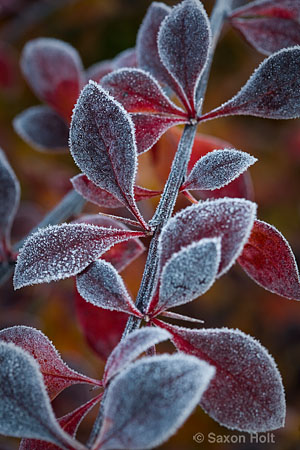 Even though I am wearing gloves, the cold steel of my tripod is beginning to numb my fingers as I ever so carefully try to find a composition that puts the frosted leaves of one branch in front of red foliage below – where the frost has not penetrated.
Even though I am wearing gloves, the cold steel of my tripod is beginning to numb my fingers as I ever so carefully try to find a composition that puts the frosted leaves of one branch in front of red foliage below – where the frost has not penetrated.
Macro composition can be a very delicate process. There is so little focusing depth of field that the slightest shift of the camera can make a huge difference. But that very same narrow focal plane allows the background to go completely out of focus, drawing attention to that area that is in focus.
So despite fingers that are now fumbling around the camera controls, I work this hoary berberis a little more. After all, the warmth of my office is only a few steps away, I am not exactly hiking in the mountains.
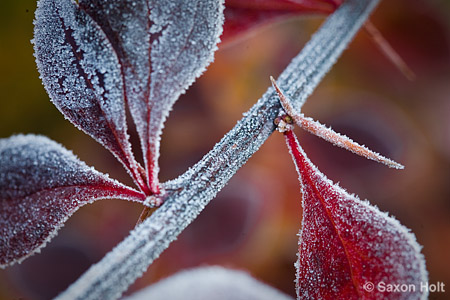
Here I use a compositional trick that uses a diagonal line to divide the frame into two equal parts, trying to balance each remaining space with shapes that draw the eye back to the two small nodes that are the design focus of the photograph. A bit of yin and yang.
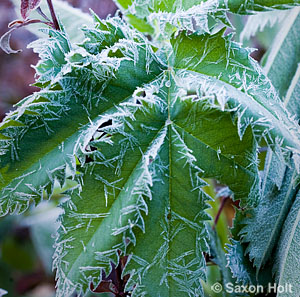 Some plants respond to frost in different ways. I have no idea how this Honeybush (Melianthus) got to have little crystal logs of ice all over it. It makes sense that dew becomes the frost we see on the other plants, but what explains this pattern I wonder.
Some plants respond to frost in different ways. I have no idea how this Honeybush (Melianthus) got to have little crystal logs of ice all over it. It makes sense that dew becomes the frost we see on the other plants, but what explains this pattern I wonder.
Garden books tell me this plant is not hardy and will not survive the cold. It doesn’t survive as an evergreen, but I quite appreciate that this rampant grower dies back to the ground every year for me.
The real star of my frost garden has always been ‘Alice’ the Oaklaef Hydrangea. 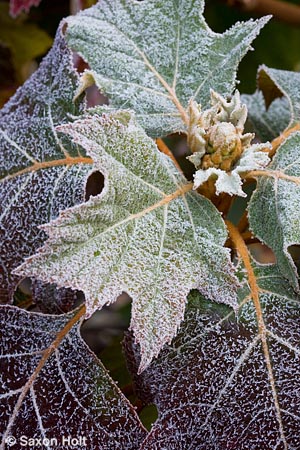 Even in times of light frost the intricate little veins that run all through these oversized leaves become white rivers and rivulets. And I love the oakleaf shape that reminds me of holly.
Even in times of light frost the intricate little veins that run all through these oversized leaves become white rivers and rivulets. And I love the oakleaf shape that reminds me of holly.
Dusted with frost, I can almost imagine I am in a climate that actually has real winter. And then I snap back to reality, happy that I enjoy these wintry thoughts through the magic of a garden plant and wee bit of frost.
Note the composition of the leaves that have the yellow central veins all directing the eye to an off-center focal point, at the same time isolating and framing the one whole leaf in the picture.
‘Alice’ has always provided good garden color in autumn. 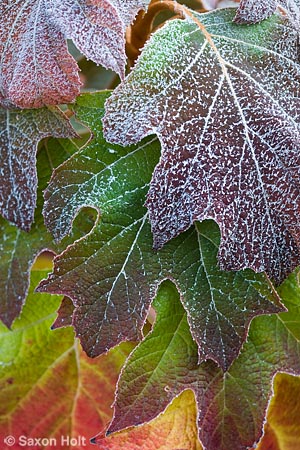 Sometimes deep mahogany, sometimes oranges and yellows; often in layers depending on where each leaf lives in the shrub.
Sometimes deep mahogany, sometimes oranges and yellows; often in layers depending on where each leaf lives in the shrub.
One might think that the whole garden is full of all these colorful leaves and winter vignettes. Actually the photographer has to go looking for them.
The frosty morning gave me an excuse to go looking for something a bit different, but the camera always lies – each of these photos is a carefully composed little image that one day I might be able to sell to a publisher as evidence of a winter garden. I just won’t say it’s in California.
But out there in the cold it felt like winter. My assistant is now arriving for work and the cold seems to have given him inspiration to take photos … of me.
